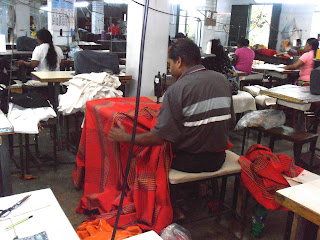In the bus we headed to Beach Road that runs along this seafront, the railway line separating us from the sand. Travelling to Dehiwela to view temple paintings proved to be a bit more confusing than I anticipated, as there are many temples within this relatively small area. Eventually we found the right one, to meet up with Ninel Fernando, a textile designer and teacher, who had organised the visit for us.
The bus was manoeuvred up a narrow, ascending path off the Galle Road that opened out into a large compound where the traditional assortment of temple buildings assembled themselves in a spacious composition. Most temple complexes are comprised of several components, necessary for their functions of worship and dwelling. The three essentials are an image house, a dagoba and bo tree enclosure. Larger temple sites may have subsidiary shrines and those attached to monasteries have prayer halls, called poyages, dormitories and refectories for resident monks.
The bo tree enclosure is a uniquely Sri Lankan feature and provides a living link to the tree under which the Buddha meditated and attained enlightenment. Cuttings taken from the original tree made their way to the first capital of Sri Lanka, Anuradhapura (about 300 B. C.) and from this tree were dispersed throughout the island over the centuries. Wherever it grows it is regarded as a sacred symbol of Buddhism.
Looking towards the bo tree enclosure
Dagobas, or stupas originally developed in shape from Indian burial mounds and were built to enshrine relics of the Buddha. They have a "bell" or "bubble" shape and are generally solid structures that peak in a central spire that symbolises the axis mundi, or cosmic spire that connects earth to heaven. They vary in size and importance from temple to temple.
The Dagoba
A typical image house
Leaving our shoes on the stone verandah of the rectangular building that contains the image house, we walked along its exterior walls to look at the wonderfully intricate paintings inscribed on their surface.
The present paintings date from 1820 in the British period and are of a very high standard in comparison to other temples of the time and are also comparatively well preserved. They interestingly show a lot of detail in modes of dress, ornament and customs of the Colonial period although they are supposed to relate the life of the Buddha or the stories of some of his 550 prior births. Sailing vessels and muskets are incorporated into the parables illustrating good deeds for the laity to follow in search of a virtuous life! They are delightful in their incongruity, and the paintings themselves are beautifully rendered. Unfortunately the caretaker, a disgruntled man in a dirty banyan (singlet) would not let us take photographs. Eventually he grudgingly opened the locked door of the image house, but once again, photography was prohibited.
The curiosity that we were allowed to photograph comprised extensive mosaics that decorated the floor of the image house and walls of another external building. Composed of broken crockery, they yielded a crazy patchwork of delicate images in a juxtaposition of cultures and craftsmanship.
 |
Mosaics
The prayer hall
Bell tower





























.jpg)























